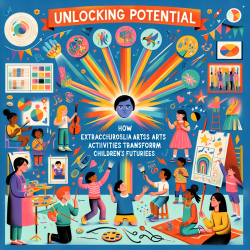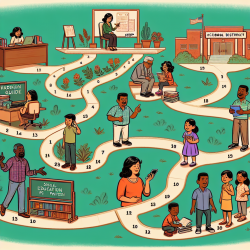Introduction
In the realm of child development, the pursuit of nurturing well-rounded individuals is paramount. A recent study titled "Associations between extracurricular arts activities, school-based arts engagement, and subsequent externalising behaviours in the Early Childhood Longitudinal Study" sheds light on the profound impact of arts engagement on children's behavioral outcomes. As practitioners dedicated to fostering positive development in children, understanding and implementing the findings of this research can be transformative.
The Power of Extracurricular Arts Activities
The study conducted by Fluharty et al. (2023) reveals a compelling association between extracurricular arts activities and a reduction in externalising behaviours among children. Externalising behaviours, such as conduct problems and hyperactivity, are linked to adverse long-term outcomes, including academic underachievement and social difficulties. However, engaging in arts activities outside the classroom appears to mitigate these risks.
Data from the Early Childhood Longitudinal Study, which tracked children from 5th to 8th grade, demonstrated that those who participated in a greater number of extracurricular arts activities exhibited fewer externalising behaviours. This suggests that arts engagement serves as a protective factor, offering children a constructive outlet for self-expression and emotional regulation.
Implementing the Findings in Practice
For practitioners in speech language pathology and related fields, integrating arts-based interventions into therapeutic practices can enhance outcomes for children. Here are some actionable steps to consider:
- Encourage Arts Participation: Advocate for increased access to extracurricular arts programs within schools and communities. Collaborate with educators and parents to identify opportunities for children to engage in activities such as music, dance, and visual arts.
- Incorporate Arts in Therapy: Utilize arts-based techniques as part of therapeutic interventions. Activities like drawing, storytelling, and role-playing can help children develop communication skills and emotional resilience.
- Foster Creativity: Create an environment that encourages creativity and self-expression. Provide children with materials and opportunities to explore their artistic interests, fostering a sense of accomplishment and self-esteem.
Further Research and Exploration
While the study highlights the benefits of extracurricular arts activities, it also underscores the need for further research. Exploring the specific mechanisms through which arts engagement influences behavior can inform more targeted interventions. Additionally, understanding the role of socioeconomic factors and accessibility in arts participation can help address disparities and ensure equitable opportunities for all children.
Conclusion
As practitioners, our commitment to creating positive outcomes for children drives us to seek innovative approaches. The findings of this study offer a compelling case for the integration of arts engagement into our practices. By harnessing the transformative power of the arts, we can unlock the potential within each child, paving the way for a brighter future.
To read the original research paper, please follow this link: Associations between extracurricular arts activities, school-based arts engagement, and subsequent externalising behaviours in the Early Childhood Longitudinal Study.










